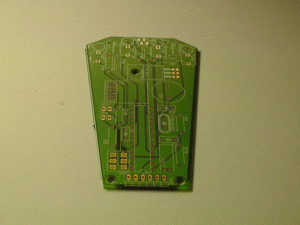HSC2011/Hardware
< HSC2011
Hardware Specification
An EduBuzzer contains an ATMega328 connected to:
- 4 buttons in distinct colours (red / blue / green / yelow)
- 4 LEDs matching the buttons
- an RGB LED
- a piezo buzzer
- a 1-wire interface for authentication buttons (iButton)
- an RF transceiver (RFM12B 868MHz model)
- a 9V block battery and a power switch
For ease of development and as to make an EduBuzzer expandable to an EduBuzzer base station, a serial line is exposed for connection with an "FTDI cable" -- power supply, RX/TX, reset button. Thus, the devices can be flashed using a bootloader.
The design takes care to stay compatible with the Arduino even if not Arduino is used in the final version. Thus, prototypes can be built on Arduino shields as well.
PCB
The PCBs are described as Eagle files in the project repository in the hardware directory in buzzer.{brd,sch}. It is routed on two sides and has three big holes for mounting inside the EduBuzzer.
For prototypes based on an Arduino, a reduced wiring scheme is described in hardware/arduino_schield.sch, which can be reproduced on an Arduino prototyping shield or a custom shield described in hardware/arduino_schield.brd. Those devices won't fit in the cases, apart from that, are fully usable as well.
For further information, read the building documentation.
Part list
This describes all the electronic parts required for completing the buzzer shield. Parts not needed in combination with an Arduino have their count as the second one in the Amount column. The Bauteilsortiment column refers to where you can find them in the metalab's parts repository.
| Partname | Amount | Position on PCB | Bauteilsortiment | notes |
|---|---|---|---|---|
| LED 5mm BLUE | 1 | D1 | - | |
| LED 5mm GREEN | 1 | D2 | G4 | |
| LED 5mm YELLOW | 1 | D3 | - | |
| LED 5mm RED | 1 | D4 | H4 | |
| Pushbutton | 4 | SW1, SW2, SW3, SW4 | E9 | |
| LF50CV | 1 (0) | VREG1 | G6 | |
| Piezo beeper | 1 | U3 | S7 | |
| 2x16 Pol, RM 2.00 | 1 | U1 | C5 | cut down to 2x6 pin socket |
| RFM12B Radio module | 1 | U1 | K8 | solder antenna to the big hole next to the letters 'M1' on the back side |
| 28 PIN DIP Socket | 1 (0) | IC4 | D9 | |
| ATMEGA328P | 1 (0) | IC4 | - | |
| 10 uF Capacitor (elko) | 1 | C4 | E0 | |
| 22 pF Capacitor (ceramic) | 2 (0) | C1, C2 | A2 | |
| 100 nF Capacitor (ceramic) | 1 (0) | C3 | C2 | imprint under hole |
| 16 Mhz Crystal | 1 | CRYSTAL1 | L0 | |
| 9V battery clip | 1 (0) | JP3 | T3 | imprint should say +/- not J3 ;) |
| 6x100mil 90° jumper header | 1 (0) | JP4 | B6 | FTDI connector |
| Resistor 100 ohm | 1 (0) | R10 | N1 | do not place! (for Arduino reset behavior compatibility) |
| Resistor 10K ohm | 1 (0) | P9 | P3 | desc should be R9 not P9 |
| Resistor 1K ohm | 7 | R5, R6, R7, R11, R12, R13 | O2 | |
| Resistor 680 ohm | 4 | R1,R2,R3,R4 | ? | am plan noch als 1k eingezeichnet |
| Resistor 4K7 ohm | 1 | R8 | - | |
| RGB LED 5mm | 1 | D5 | - | |
| Switch MIYAMA MS 245 | 1 (0) | SW5 | S9 | connect over cable! |
Enclosure
The enclosure design is documented on its own page.
